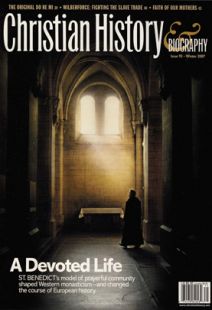The Tale of Peter Abbot
When Peter the Venerable (1092–1156) became abbot of Cluny in 1122, that grand experiment in monasticism was already over 200 years old. Many felt that powerful Cluny—with its massive Abbey Church, its extensive library, and its numerous priories—had become too worldly and was itself in need of reform. After all, no real monk needed the indoor plumbing that Cluny had!
Enter Peter, the son of a nobleman of Montboissier, who had taken monastic vows in his teens and quickly moved up the monastic hierarchy.
After his election as abbot of Cluny, Peter instituted a series of reforms intended to restore discipline to the priories, assure the financial health of the monastery, and boost the educational level of the monks. This reform itself was controversial; Peter frequently sparred with his friend Bernard of the rival monastery at Clairvaux, who believed that the central concerns of the monk should not be property and education, but prayer and work.
In addition to being a powerful figure in the church, Peter was also a creative and insightful apologist. For example, he arranged for Islamic texts, including the Qur'an, to be translated into Latin for the first time, allowing Christian apologists to study and critique Muslim theology more precisely than ever before. He also left behind a large corpus of letters that reveal the theological concerns of the 12th century in imaginative ways. (In one letter, he mentions that the abbey’s manuscript of St. Augustine’s letters had been “accidentally eaten by a bear”; Peter probably wished they had been Bernard’s!)
Peter died at Cluny on Christmas Day in 1156. The influence of the monastery he loved was quickly fading, and the abbot who had been labeled the Venerable because of his godliness and his passion for reform became its evening star.
By Garry Crites
[Christian History originally published this article in Christian History Issue #93 in 2007]
Next articles
Living like a monk in the “real world”
Count Gerald of Aurillac took the values of the monastery into the realm of everyday life—and the battlefield.
Dennis MartinBenedict, a devoted life: Recommended Resources
Dig deeper into this issue's theme
The authors and editorsChristian History Timeline: Benedict and the Rise of Western Monasticism
From its roots in the early Eastern church, through the Benedictine centuries, to the birth of new kinds of religious orders in the Middle Ages
compiled by Antonia Ryan with contributions from Carmen Acevedo ButcherSupport us
Christian History Institute (CHI) is a non-profit Pennsylvania corporation founded in 1982. Your donations support the continuation of this ministry
Donate




